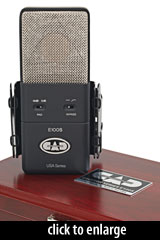
CAD E100S – First Listen
Saturday, March 12th, 2011 | by matthew mcglynn
 My friends at CAD sent out an E100S for evaluation. The timing is great, because we’re giving away one of these in about two weeks — see the contest!
My friends at CAD sent out an E100S for evaluation. The timing is great, because we’re giving away one of these in about two weeks — see the contest!
I put the E100S up against some of my favorite mics to get a baseline on the mic’s performance. So far, I am impressed! Check out the audio files below to see if you agree.
Hammer Dulcimer
 CAD Audio E100S[audio:http://recordinghacks.com/sounds/samples/e100S/dulcimer-e100s.mp3]
CAD Audio E100S[audio:http://recordinghacks.com/sounds/samples/e100S/dulcimer-e100s.mp3]
 Audio-Technica AT4047MP[audio:http://recordinghacks.com/sounds/samples/e100S/dulcimer-at4047mp-c.mp3]
Audio-Technica AT4047MP[audio:http://recordinghacks.com/sounds/samples/e100S/dulcimer-at4047mp-c.mp3]
These two mics are both FET condensers, but beyond that have little in common — different capsule designs and sizes, different amplifier and output circuits. Nonetheless, on this passage the two sound very similar. The E100S has a bit more more articulation in the high frequencies, and the AT4047MP has more low-frequency girth, but it’s a subtle difference. I’d use either mic without hesitation (although I’d back the mic up by 12–18'' first).
VO
(With apologies to real voice artists, I recorded myself for this one.)
First, I put the E100S side-by-side with the Lewitt LCT 640. I adjusted the preamp gain to yield the same signal level from both mics — the E100S, at 28mV/Pa, has a hotter output level than the LCT-640 (13 mV/Pa). My preamp is a BLA-modded Digi 002; samples were recorded at 24-bit/44.1kHz, then converted to MP3 via Peak LE.
 CAD Audio E100S[audio:http://recordinghacks.com/sounds/samples/e100S/E100S-VO-comp.mp3]
CAD Audio E100S[audio:http://recordinghacks.com/sounds/samples/e100S/E100S-VO-comp.mp3]
 Lewitt Professional Audio LCT 640[audio:http://recordinghacks.com/sounds/samples/e100S/LCT640-VO-comp.mp3]
Lewitt Professional Audio LCT 640[audio:http://recordinghacks.com/sounds/samples/e100S/LCT640-VO-comp.mp3]
The two MP3 samples sound very similar to one another. The original WAVs were easier to distinguish, with the LCT640 sounding a bit more compressed, and the E100S sounding a bit warmer. I don’t find any problems with popping or sibilance with either mic; they both sound great.
 Next, I recorded a short excerpt from Mixerman’s wonderful new book, Zen and the Art of Mixing
Next, I recorded a short excerpt from Mixerman’s wonderful new book, Zen and the Art of Mixing, using the E100S and a modified AKG C460B.
The C460B is not a typical VO mic. In fact, the AKG CK-series capsules are so sensitive to plosives, pop filters are mandatory for any sort of vocal use.
Originally I’d had a U87 sample here, but I’m not confident of that sample’s integrity, and I don’t have the mic on the premises for a retest. But I found the C460B to be a pretty close match for the E100S in terms of basic tonality. Further, I have the AKG CK-63 Hypercardioid capsule, which is closer to the polar pattern of the supercardioid E100S than any Cardioid mic would be.
Finally, it struck me that neither my C460B, as modified by Jim Williams of Audio Upgrades, nor the E100S have an output transformer.
The excerpt is the second of “Mixerman’s 10 Steps to Better Mixing.”
 CAD Audio E100S[audio:http://recordinghacks.com/sounds/samples/e100S/rule2-e100s-3.mp3]
CAD Audio E100S[audio:http://recordinghacks.com/sounds/samples/e100S/rule2-e100s-3.mp3]
 AKG Acoustics C 460 B[audio:http://recordinghacks.com/sounds/samples/e100S/rule2-C460BHC-3.mp3]
AKG Acoustics C 460 B[audio:http://recordinghacks.com/sounds/samples/e100S/rule2-C460BHC-3.mp3]
Both mics do a great job of capturing high-frequency detail. Tonally, I find these two mics to be extremely similar, at least on this short sample.
But there’s a distinct difference. Turn up your monitor volume and listen to the noise floor at the end of the sample — the E100S is silent! Compared to the 460B, it sounds almost gated. Awesome.
These samples were recorded at a distance of 10 inches. When worked closer, the E100S gains low end due to proximity effect. It seems to have a sweet spot at about 6 inches, where (on my voice, at least) it picks up an authoritative amount of low end without sounding muddy or rumbly.
Take one home?
If you’d like a chance to win an E100S, just log in to this month’s microphone giveaway. Update: The March giveaway prize, an E100S, was won by Jon Tidey of AudioGeekZine. Check the microphone giveaway page for this month’s prize.
We’re looking forward to trying the E100S on more voices and instruments soon.
Posted in Microphones | 7 Comments »

strangenotez
March 13th, 2011 at 12:28 pm
dude, nice comparison, truly good work and nice samples. If I had to be honest about the comparison of the U87Ai to the CAD, it sounds like the Diaphragm was pointed in the wrong direction or there was a serious impedance mismatch. maybe in the next edition you could run that test one more time!!
Thanks for your dedication-
matthew mcglynn
March 14th, 2011 at 10:40 pm
@strangenotez, if the U87 was backwards, it’s the best-sounding backward mic I’ve ever heard! But the clip did sound slightly wrong, so I’ve pulled it down until I can track it again.
slymo
March 15th, 2011 at 3:52 pm
Nice job on the tracks. Even though the 4047 is a totally different mic for sure, the test demonstrates the E100’s ability to grab those highs. I found the LCT 640 to slurr the “s” sounds. Not major sibilance but definitely poorly defined compared to the E100s which was very clear.
Steve Faul
March 24th, 2011 at 12:07 pm
I’ve been curious about the E100S for some time. Thanks for the review. It’s really hard to beat the AT4047MP, but the E100S hung right in there with great detail for that instrument. The LCT640 gave you more low end fullness to my ears, but that might’ve been the room’s acoustics getting into the pickup. Had you stepped up closer you might’ve sounded ready for FM radio. The E100S’s tighter pattern reduced the room ring nicely, keeping your voice more natural. It would be fun to hear it go up against some more VO mics. Bring on the U87!
Rob Crowston
April 21st, 2011 at 10:10 pm
About a million years ago I opened Wordnoise, we were and have always been a voice works studio. Back then, every nickel out the door counted and I had to be both penny and audio wise with my spending. I had been working big league radio production for years and I was used to playing with high end Neumann’s and AKG’s, but my budget back when I opened Wordnoise, even at it’s thinly stretched best, could just barely afford the then just released plain Jane U87 (the one without the cool box, the bottom end roll-off or the pattern changing options) At the other end of consideration and $ spectrum were a pair of the first incarnation of Stedman large caps. In between were a couple of Sennheiser’s, an AKG or two, there may have been a Beyer in there as well. They were all condensers. The local pro shop allowed me to try out a total of 9 Pairs of mics including a pair of first generation CAD 100’s over a long weekend.
The test was simple – which pair of these mics would provide me with the most realistic, natural and faithful reproduction of voice. So I called in a couple of voices I knew well, a boy and a girl, and had them read the same copy through each of the contenders. I paid careful attention to placement and levels. In the end I loaded the files into our new, ‘It’s a Brave New World – Look it’s Digital’ system, lined up the takes and listened and listened and listened.
I still have the winning pair of mics from that weekend test all those years ago. They’ve recorded a zillion V/O’s, been pressed into service as ambient mics, crossed stereo pairs, overheads – probably positions and placements that the designers never imagined they’d be used in, but that pair of CAD’s won fair and square. Terry sounded more like Terry standing beside me speaking to me and Shawn sounded as beautiful as she is. In fact I think the CAD’s were so revealing that unbeknownst to her, I was able to ‘hear’ her ’til then, secret inner need to express her love (I’m very handsome!) for me. Sadly I wasn’t wearing my ‘See Through Clothing’ eyeglasses that weekend!
A couple of notes; I would suggest that working the CAD up close is a mistake, in my opinion they sound better with a little air between them and the source. In fact, if the room can support it, quite a little more than you might at first imagine. The 100’s are extremely ’fast’ – quick rise transients are captured with an immediacy that rivals some of the best out there. S’s are a tad hot, but never splashy – a little bigger ssss with none of the shhhh. I would also disagree somewhat on the suggestion that the mics are bass shy – not in my experience. Certainly these aren’t kick drum mics, but the low end is so fast and so clean that the usual soft slow bloat of traditional large cap V/O mics might give listeners a sense of ‘something missing’ – I don’t think it is. And finally, these really are Super-cards, you gotta take the time to dial ‘em in – in other words, take careful aim before you pull the trigger.
Two cents worth at best, and from a largely non-musical perspective; but a good, natural, fast and true voice worthy mic is a hard to find tool, and I think we’d all agree that those same attributes are often exactly what we need to capture sounds that satisfy. I’m glad my pair rest comfortably in my mic closet – they’ve made me a lot of money over the years.
Rob Crowston
Wordnoise
tunes
May 20th, 2011 at 8:56 am
Having these comparisons is great. Love it.
J. P. Allen
April 28th, 2013 at 7:17 am
Thanks for the comparison. My thoughts:
– On dulcimer the two sounded very different. The 4047 sounded like it had an effect on it — most notable in the first couple of measures. I didn’t particularly like its sound.
– On voice-1 the Lewitt sounded fuller in the low frequencies, but the CAD sounded more balanced overall.
– on voice-2 the two mics were practically interchangeable. The AKG had a touch more low end.
Great shootout!